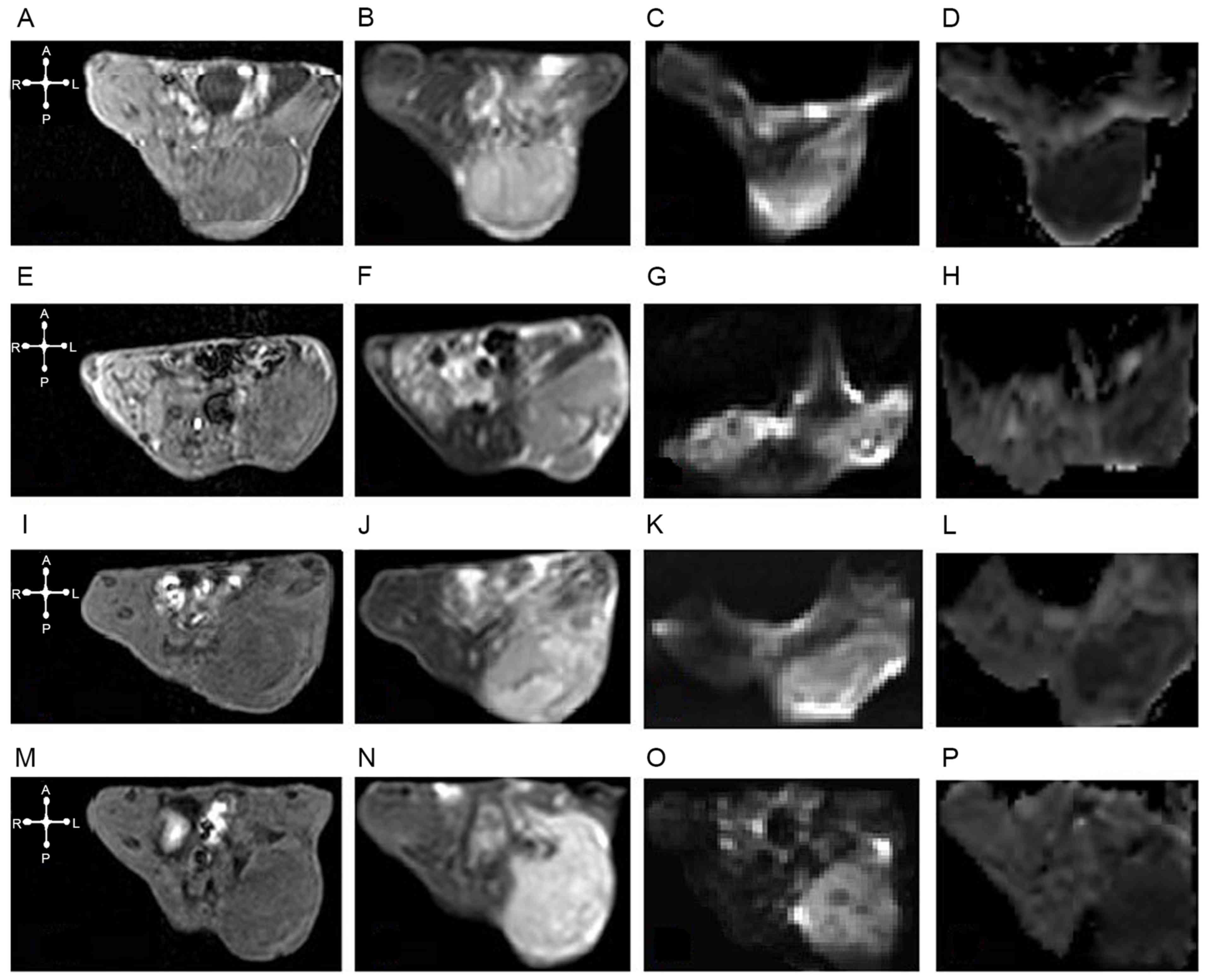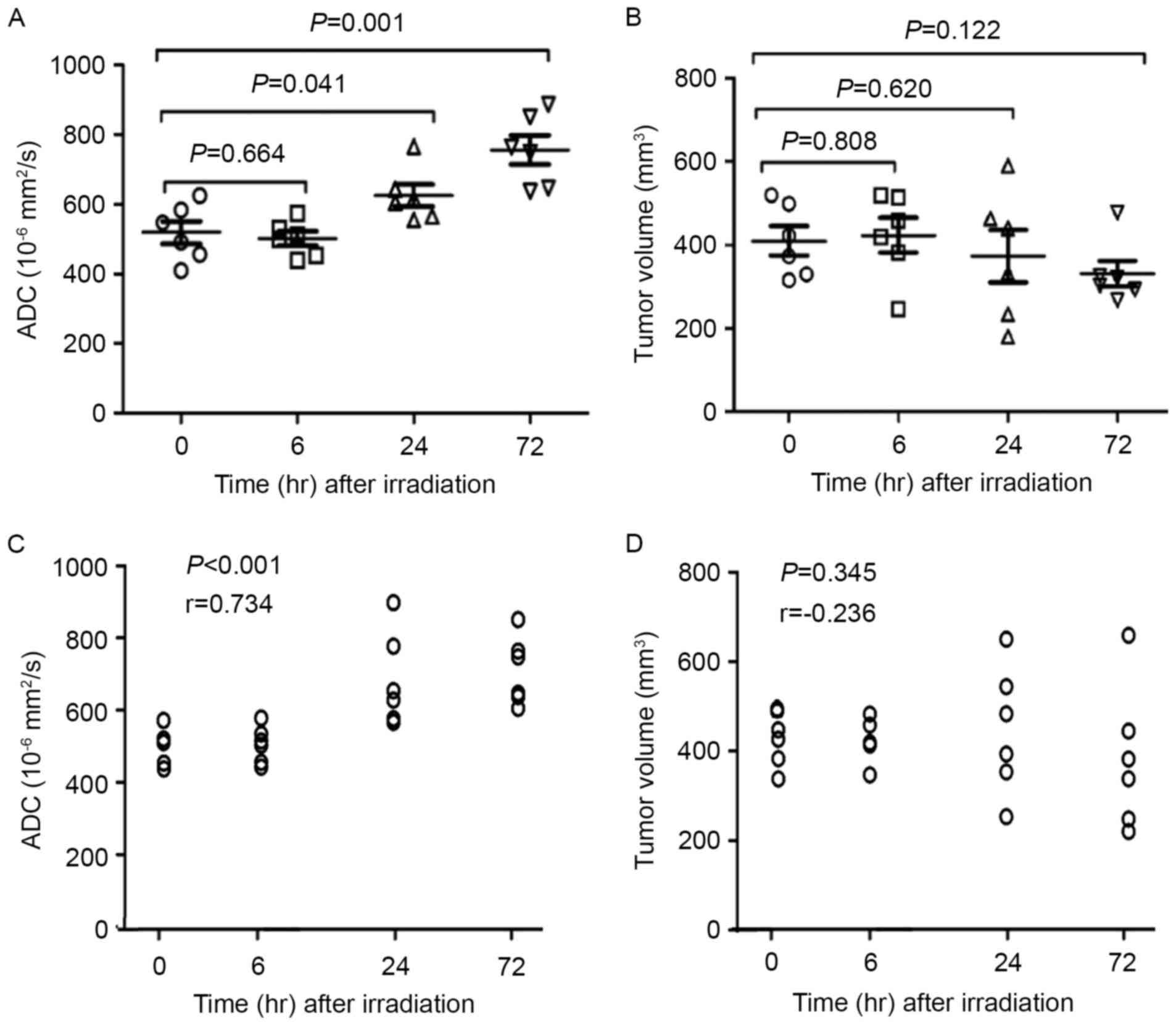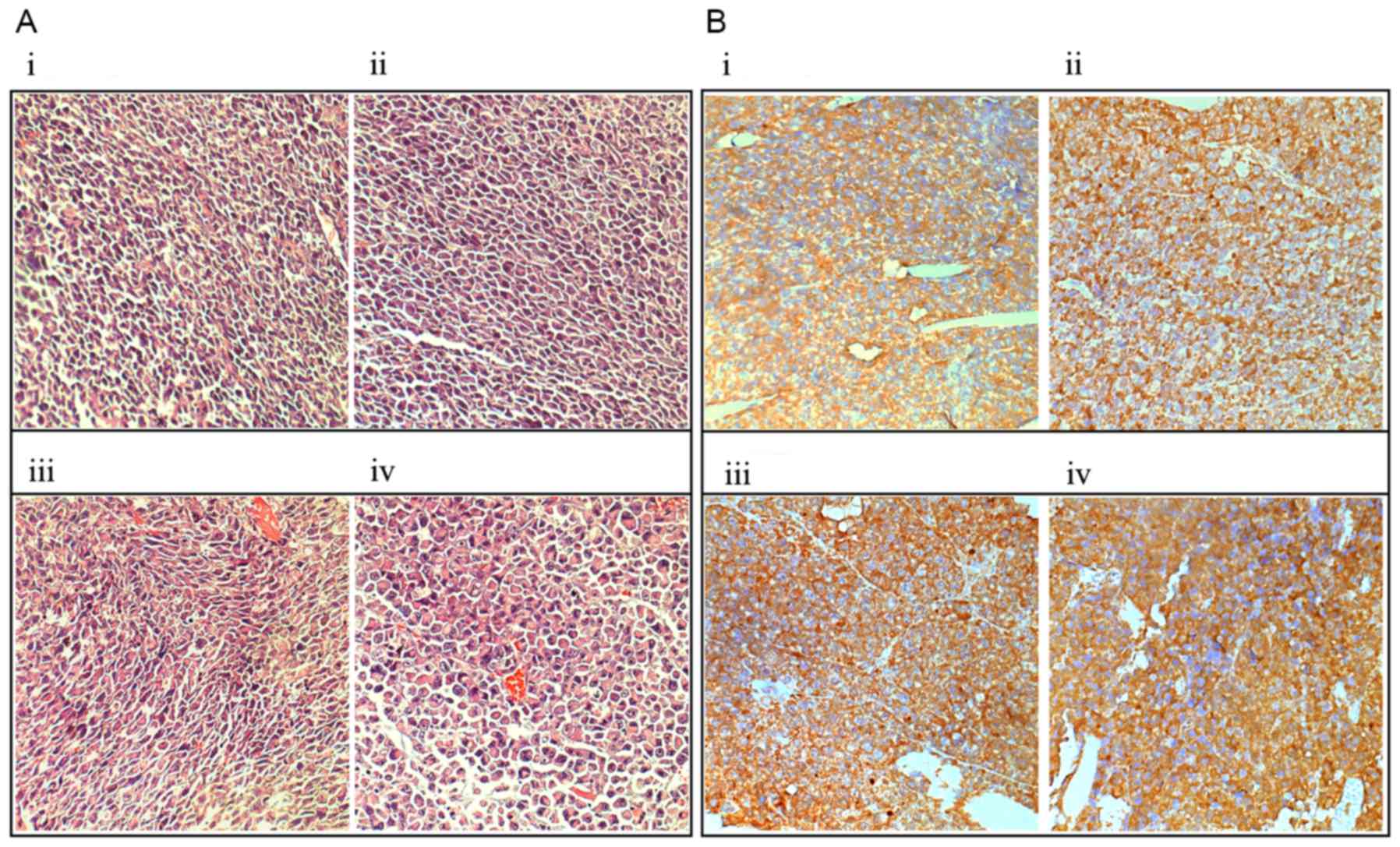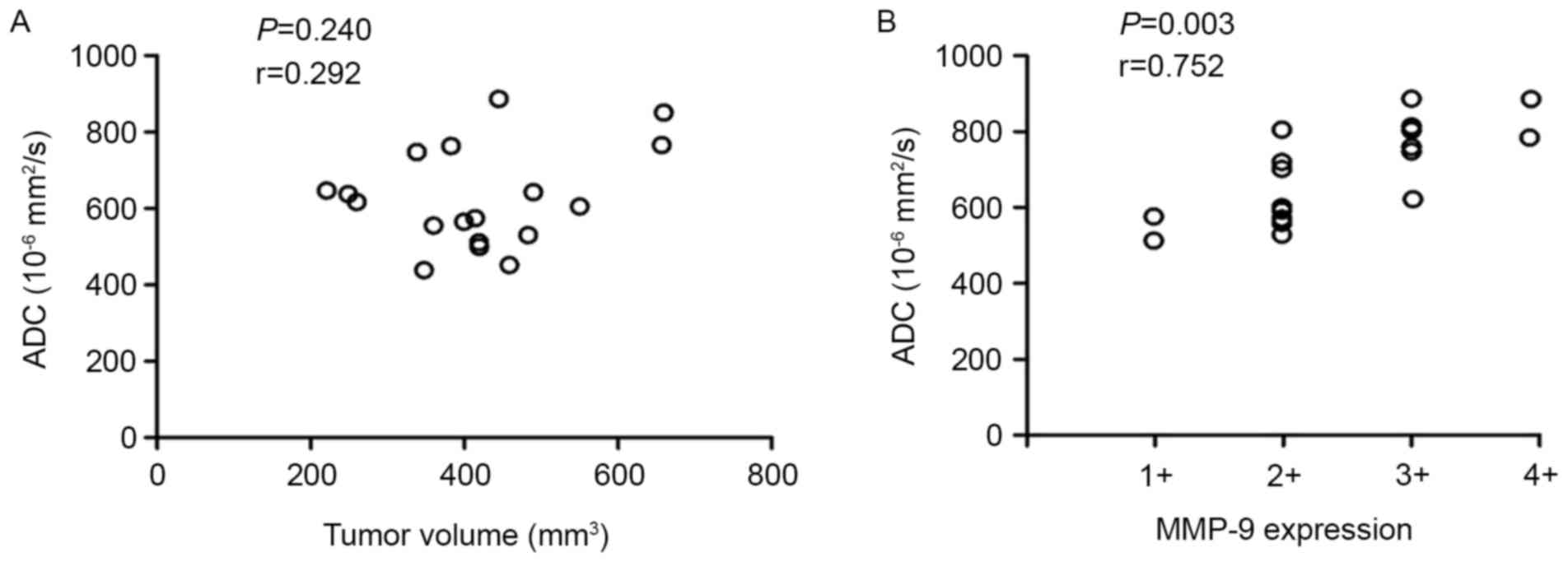|
1
|
Thoeny HC and Ross BD: Predicting and
monitoring cancer treatment response with diffusion-weighted MRI. J
Magn Reson Imaging. 32:2–16. 2010. View Article : Google Scholar : PubMed/NCBI
|
|
2
|
Rudin M: Imaging readouts as biomarkers or
surrogate parameters for the assessment of therapeutic
interventions. Eur Radiol. 17:2441–2457. 2007. View Article : Google Scholar : PubMed/NCBI
|
|
3
|
Padhani AR, Liu G, Koh DM, Chenevert TL,
Thoeny HC, Takahara T, Dzik-Jurasz A, Ross BD, Van Cauteren M,
Collins D, et al: Diffusion-weighted magnetic resonance imaging as
a cancer biomarker: Consensus and recommendations. Neoplasia.
11:102–125. 2009. View Article : Google Scholar : PubMed/NCBI
|
|
4
|
Koh DM and Collins DJ: Diffusion-weighted
MRI in the body: Applications and challenges in oncology. AJR Am J
Roentgenol. 188:1622–1635. 2007. View Article : Google Scholar : PubMed/NCBI
|
|
5
|
Szafer A, Zhong J, Anderson AW and Gore
JC: Diffusion-weighted imaging in tissues: Theoretical models. Nmr
Biomed. 8:289–296. 1995. View Article : Google Scholar : PubMed/NCBI
|
|
6
|
Matsumoto Y, Kuroda M, Matsuya R, Kato H,
Shibuya K, Oita M, Kawabe A, Matsuzaki H, Asaumi J, Murakami J, et
al: In vitro experimental study of the relationship between the
apparent diffusion coefficient and changes in cellularity and cell
morphology. Oncol Rep. 22:641–648. 2009.PubMed/NCBI
|
|
7
|
Lyng H, Haraldseth O and Rofstad EK:
Measurement of cell density and necrotic fraction in human melanoma
xenografts by diffusion weighted magnetic resonance imaging. Magn
Reson Med. 43:828–836. 2000. View Article : Google Scholar : PubMed/NCBI
|
|
8
|
Sadeghi N, Camby I, Goldman S, Gabius HJ,
Balériaux D, Salmon I, Decaesteckere C, Kiss R and Metens T: Effect
of hydrophilic components of the extracellular matrix on
quantifiable diffusion-weighted imaging of human gliomas:
Preliminary results of correlating apparent diffusion coefficient
values and hyaluronan expression level. AJR Am J Roentgenol.
181:235–241. 2003. View Article : Google Scholar : PubMed/NCBI
|
|
9
|
Vargová L, Homola A, Zámecnik J, Tichý M,
Benes V and Syková E: Diffusion parameters of the extracellular
space in human gliomas. Glia. 42:77–88. 2003. View Article : Google Scholar : PubMed/NCBI
|
|
10
|
Pope WB, Mirsadraei L, Lai A, Eskin A,
Qiao J, Kim HJ, Ellingson B, Nghiemphu PL, Kharbanda S, Soriano RH,
et al: Differential gene expression in glioblastoma defined by ADC
histogram analysis: Relationship to extracellular matrix molecules
and survival. AJNR Am J Neuroradiol. 33:1059–1064. 2012. View Article : Google Scholar : PubMed/NCBI
|
|
11
|
Stamenkovic I: Extracellular matrix
remodelling: The role of matrix metalloproteinases. J Pathol.
200:448–464. 2003. View Article : Google Scholar : PubMed/NCBI
|
|
12
|
Kessenbrock K, Plaks V and Werb Z: Matrix
metalloproteinases: Regulators of the tumor microenvironment. Cell.
141:52–67. 2010. View Article : Google Scholar : PubMed/NCBI
|
|
13
|
Liu CH, You Z, Liu CM, Kim YR, Whalen MJ,
Rosen BR and Liu PK: Diffusion-weighted magnetic resonance imaging
reversal by gene knockdown of matrix metalloproteinase-9 activities
in live animal brains. J Neurosci. 29:3508–3517. 2009. View Article : Google Scholar : PubMed/NCBI
|
|
14
|
Libra M, Scalisi A, Vella N, Clementi S,
Sorio R, Stivala F, Spandidos DA and Mazzarino C: Uterine cervical
carcinoma: Role of matrix metalloproteinases (review). Int J Oncol.
34:897–903. 2009. View Article : Google Scholar : PubMed/NCBI
|
|
15
|
Nirmala C, Jasti SL, Sawaya R, Kyritsis
AP, Konduri SD, Ali-Osman F, Rao JS and Mohanam S: Effects of
radiation on the levels of MMP-2, MMP-9 and TIMP-1 during
morphogenic glial-endothelial cell interactions. Int J Cancer.
88:766–771. 2000. View Article : Google Scholar : PubMed/NCBI
|
|
16
|
Chou CH, Teng CM, Tzen KY, Chang YC, Chen
JH and Cheng JC: MMP-9 from sublethally irradiated tumor promotes
Lewis lung carcinoma cell invasiveness and pulmonary metastasis.
Oncogene. 31:458–468. 2012. View Article : Google Scholar : PubMed/NCBI
|
|
17
|
Kim HS, Kim CK, Park BK, Huh SJ and Kim B:
Evaluation of therapeutic response to concurrent chemoradiotherapy
in patients with cervical cancer using diffusion-weighted MR
imaging. J Magn Reson Imaging. 37:187–193. 2013. View Article : Google Scholar : PubMed/NCBI
|
|
18
|
Spielmann H: FRAME annual lecture.
International co-operation: An essential requirement for replacing
animal toxicity tests. Altern Lab Anim. 29:637–648. 2001.PubMed/NCBI
|
|
19
|
Rhodes LV, Short SP, Neel NF, Salvo VA,
Zhu Y, Elliott S, Wei Y, Yu D, Sun M, Muir SE, et al: Cytokine
receptor CXCR4 mediates estrogen-independent tumorigenesis,
metastasis, and resistance to endocrine therapy in human breast
cancer. Cancer Res. 71:603–613. 2011. View Article : Google Scholar : PubMed/NCBI
|
|
20
|
Cui Y, Zhang XP, Sun YS, Tang L and Shen
L: Apparent diffusion coefficient: Potential imaging biomarker for
prediction and early detection of response to chemotherapy in
hepatic metastases. Radiology. 248:894–900. 2008. View Article : Google Scholar : PubMed/NCBI
|
|
21
|
Seierstad T, Folkvord S, Røe K, Flatmark
K, Skretting A and Olsen DR: Early changes in apparent diffusion
coefficient predict the quantitative antitumoral activity of
capecitabine, oxaliplatin, and irradiation in HT29 xenografts in
athymic nude mice. Neoplasia. 9:392–400. 2007. View Article : Google Scholar : PubMed/NCBI
|
|
22
|
Makino H, Kato H, Furui T, Morishige K and
Kanematsu M: Predictive value of diffusion-weighted magnetic
resonance imaging during chemoradiotherapy for uterine cervical
cancer. J Obstet Gynaecol Res. 40:1098–1104. 2014. View Article : Google Scholar : PubMed/NCBI
|
|
23
|
Song I, Kim CK, Park BK and Park W:
Assessment of response to radiotherapy for prostate cancer: Value
of diffusion-weighted MRI at 3 T. AJR Am J Roentgenol.
194:W477–W482. 2010. View Article : Google Scholar : PubMed/NCBI
|
|
24
|
Park JJ, Kim CK, Park SY, Simonetti AW,
Kim E, Park BK and Huh SJ: Assessment of early response to
concurrent chemoradiotherapy in cervical cancer: Value of
diffusion-weighted and dynamic contrast-enhanced MR imaging. Magn
Reson Imaging. 32:993–1000. 2014. View Article : Google Scholar : PubMed/NCBI
|
|
25
|
Chen J, Xia J, Zhou YC, Xia LM, Zhu WZ,
Zou ML, Feng DY and Wang CY: Correlation between magnetic resonance
diffusion weighted imaging and cell density in astrocytoma.
Zhonghua Zhong Liu Za Zhi. 27:309–311. 2005.(In Chinese).
PubMed/NCBI
|
|
26
|
Humphries PD, Sebire NJ, Siegel MJ and
Olsen ØE: Tumors in pediatric patients at diffusion-weighted MR
imaging: Apparent diffusion coefficient and tumor cellularity.
Radiology. 245:848–854. 2007. View Article : Google Scholar : PubMed/NCBI
|
|
27
|
Chen L, Liu M, Bao J, Xia Y, Zhang J,
Zhang L, Huang X and Wang J: The correlation between apparent
diffusion coefficient and tumor cellularity in patients: A
meta-analysis. PLoS One. 8:e790082013. View Article : Google Scholar : PubMed/NCBI
|
|
28
|
Chen L, Zhang J, Chen Y, Wang W, Zhou X,
Yan X and Wang J: Relationship between apparent diffusion
coefficient and tumour cellularity in lung cancer. PLoS One.
9:e998652014. View Article : Google Scholar : PubMed/NCBI
|
|
29
|
Kishimoto K, Tajima S, Maeda I, Takagi M,
Ueno T, Suzuki N and Nakajima Y: Endometrial cancer: Correlation of
apparent diffusion coefficient (ADC) with tumor cellularity and
tumor grade. Acta Radiol. 57:1021–1028. 2016. View Article : Google Scholar : PubMed/NCBI
|
|
30
|
Manenti G, Di Roma M, Mancino S,
Bartolucci DA, Palmieri G, Mastrangeli R, Miano R, Squillaci E and
Simonetti G: Malignant renal neoplasms: Correlation between ADC
values and cellularity in diffusion weighted magnetic resonance
imaging at 3 T. Radiol Med. 113:199–213. 2008.(In English,
Italian). View Article : Google Scholar : PubMed/NCBI
|
|
31
|
Verkman AS: Diffusion in the extracellular
space in brain and tumors. Phys Biol. 10:450032013. View Article : Google Scholar
|
|
32
|
Sood R, Yang Y, Taheri S, Candelario-Jalil
E, Estrada EY, Walker EJ, Thompson J and Rosenberg GA: Increased
apparent diffusion coefficients on MRI linked with matrix
metalloproteinases and edema in white matter after bilateral
carotid artery occlusion in rats. J Cereb Blood Flow Metab.
29:308–316. 2009. View Article : Google Scholar : PubMed/NCBI
|
|
33
|
Lee WH, Warrington JP, Sonntag WE and Lee
YW: Irradiation alters MMP-2/TIMP-2 system and collagen type IV
degradation in brain. Int J Radiat Oncol Biol Phys. 82:1559–1566.
2012. View Article : Google Scholar : PubMed/NCBI
|
|
34
|
Keating M, Kurup A, Alvarez-Elizondo M,
Levine AJ and Botvinick E: Spatial distributions of pericellular
stiffness in natural extracellular matrices are dependent on
cell-mediated proteolysis and contractility. Acta Biomater.
57:304–312. 2017. View Article : Google Scholar : PubMed/NCBI
|
|
35
|
Cheng JC, Chou CH, Kuo ML and Hsieh CY:
Radiation-enhanced hepatocellular carcinoma cell invasion with
MMP-9 expression through PI3K/Akt/NF-kappaB signal transduction
pathway. Oncogene. 25:7009–7018. 2006. View Article : Google Scholar : PubMed/NCBI
|
|
36
|
Wang AM, Cao P, Yee A, Chan D and Wu EX:
Detection of extracellular matrix degradation in intervertebral
disc degeneration by diffusion magnetic resonance spectroscopy.
Magn Reson Med. 73:1703–1712. 2015. View Article : Google Scholar : PubMed/NCBI
|
|
37
|
Matsumoto Y, Kuroda M, Matsuya R, Kato H,
Shibuya K, Oita M, Kawabe A, Matsuzaki H, Asaumi J, Murakami J, et
al: In vitro experimental study of the relationship between the
apparent diffusion coefficient and changes in cellularity and cell
morphology. Oncol Rep. 22:641–648. 2009.PubMed/NCBI
|
|
38
|
Zhang H and Verkman AS: Microfiberoptic
measurement of extracellular space volume in brain and tumor slices
based on fluorescent dye partitioning. Biophys J. 99:1284–1291.
2010. View Article : Google Scholar : PubMed/NCBI
|
|
39
|
Yoon JH, Son JW, Chung H, Park CH, Kim YJ,
Chang HJ, Hong GR, Kim TH, Ha JW, Choi BW, et al: Relationship
between myocardial extracellular space expansion estimated with
post-contrast T1 mapping MRI and left ventricular remodeling and
neurohormonal activation in patients with dilated cardiomyopathy.
Korean J Radiol. 16:1153–1162. 2015. View Article : Google Scholar : PubMed/NCBI
|



















